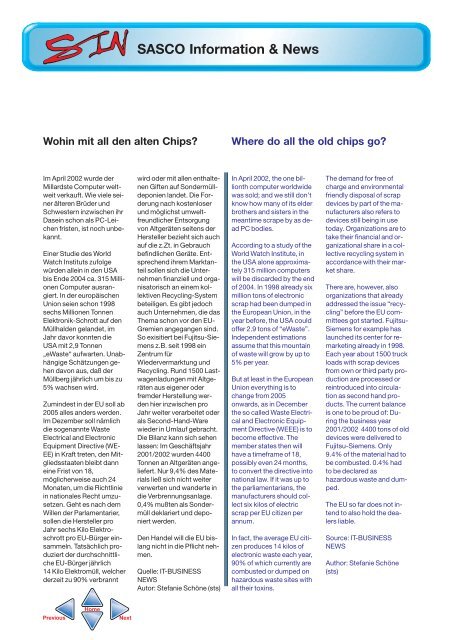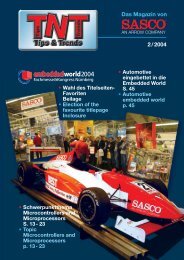steht die TNT als PDF zum Download - ISI-Design
steht die TNT als PDF zum Download - ISI-Design
steht die TNT als PDF zum Download - ISI-Design
Sie wollen auch ein ePaper? Erhöhen Sie die Reichweite Ihrer Titel.
YUMPU macht aus Druck-PDFs automatisch weboptimierte ePaper, die Google liebt.
Im April 2002 wurde der<br />
Millardste Computer weltweit<br />
verkauft. Wie viele seiner<br />
älteren Brüder und<br />
Schwestern inzwischen ihr<br />
Dasein schon <strong>als</strong> PC-Leichen<br />
fristen, ist noch unbekannt.<br />
Einer Stu<strong>die</strong> des World<br />
Watch Instituts zufolge<br />
würden allein in den USA<br />
bis Ende 2004 ca. 315 Millionen<br />
Computer ausrangiert.<br />
In der europäischen<br />
Union seien schon 1998<br />
sechs Millionen Tonnen<br />
Elektronik-Schrott auf den<br />
Müllhalden gelandet, im<br />
Jahr davor konnten <strong>die</strong><br />
USA mit 2,9 Tonnen<br />
„eWaste“ aufwarten. Unabhängige<br />
Schätzungen gehen<br />
davon aus, daß der<br />
Müllberg jährlich um bis zu<br />
5% wachsen wird.<br />
Zumindest in der EU soll ab<br />
2005 alles anders werden.<br />
Im Dezember soll nämlich<br />
<strong>die</strong> sogenannte Waste<br />
Electrical and Electronic<br />
Equipment Directive (WE-<br />
EE) in Kraft treten, den Mitgliedsstaaten<br />
bleibt dann<br />
eine Frist von 18,<br />
möglicherweise auch 24<br />
Monaten, um <strong>die</strong> Richtlinie<br />
in nationales Recht umzusetzen.<br />
Geht es nach dem<br />
Willen der Parlamentarier,<br />
sollen <strong>die</strong> Hersteller pro<br />
Jahr sechs Kilo Elektroschrott<br />
pro EU-Bürger einsammeln.<br />
Tatsächlich produziert<br />
der durchschnittliche<br />
EU-Bürger jährlich<br />
14 Kilo Elektromüll, welcher<br />
derzeit zu 90% verbrannt<br />
SASCO Information & News<br />
Wohin mit all den alten Chips? Where do all the old chips go?<br />
Home<br />
Previous Next<br />
wird oder mit allen enthaltenen<br />
Giften auf Sondermülldeponien<br />
landet. Die Forderung<br />
nach kostenloser<br />
und möglichst umweltfreundlicher<br />
Entsorgung<br />
von Altgeräten seitens der<br />
Hersteller bezieht sich auch<br />
auf <strong>die</strong> z.Zt. in Gebrauch<br />
befindlichen Geräte. Entsprechend<br />
ihrem Marktanteil<br />
sollen sich <strong>die</strong> Unternehmen<br />
finanziell und organisatorisch<br />
an einem kollektiven<br />
Recycling-System<br />
beteiligen. Es gibt jedoch<br />
auch Unternehmen, <strong>die</strong> das<br />
Thema schon vor den EU-<br />
Gremien angegangen sind.<br />
So exisitiert bei Fujitsu-Siemens<br />
z.B. seit 1998 ein<br />
Zentrum für<br />
Wiedervermarktung und<br />
Recycling. Rund 1500 Lastwagenladungen<br />
mit Altgeräten<br />
aus eigener oder<br />
fremder Herstellung werden<br />
hier inzwischen pro<br />
Jahr weiter verarbeitet oder<br />
<strong>als</strong> Second-Hand-Ware<br />
wieder in Umlauf gebracht.<br />
Die Bilanz kann sich sehen<br />
lassen: Im Geschäftsjahr<br />
2001/2002 wurden 4400<br />
Tonnen an Altgeräten angeliefert.<br />
Nur 9,4% des Materi<strong>als</strong><br />
ließ sich nicht weiter<br />
verwerten und wanderte in<br />
<strong>die</strong> Verbrennungsanlage.<br />
0,4% mußten <strong>als</strong> Sondermüll<br />
deklariert und deponiert<br />
werden.<br />
Den Handel will <strong>die</strong> EU bislang<br />
nicht in <strong>die</strong> Pflicht nehmen.<br />
Quelle: IT-BUSINESS<br />
NEWS<br />
Autor: Stefanie Schöne (sts)<br />
In April 2002, the one billionth<br />
computer worldwide<br />
was sold; and we still don’t<br />
know how many of its elder<br />
brothers and sisters in the<br />
meantime scrape by as dead<br />
PC bo<strong>die</strong>s.<br />
According to a study of the<br />
World Watch Institute, in<br />
the USA alone approximately<br />
315 million computers<br />
will be discarded by the end<br />
of 2004. In 1998 already six<br />
million tons of electronic<br />
scrap had been dumped in<br />
the European Union, in the<br />
year before, the USA could<br />
offer 2.9 tons of “eWaste”.<br />
Independent estimations<br />
assume that this mountain<br />
of waste will grow by up to<br />
5% per year.<br />
But at least in the European<br />
Union everything is to<br />
change from 2005<br />
onwards, as in December<br />
the so called Waste Electrical<br />
and Electronic Equipment<br />
Directive (WEEE) is to<br />
become effective. The<br />
member states then will<br />
have a timeframe of 18,<br />
possibly even 24 months,<br />
to convert the directive into<br />
national law. If it was up to<br />
the parliamentarians, the<br />
manufacturers should collect<br />
six kilos of electric<br />
scrap per EU citizen per<br />
annum.<br />
In fact, the average EU citizen<br />
produces 14 kilos of<br />
electronic waste each year,<br />
90% of which currently are<br />
combusted or dumped on<br />
hazardous waste sites with<br />
all their toxins.<br />
The demand for free of<br />
charge and environmental<br />
friendly disposal of scrap<br />
devices by part of the manufacturers<br />
<strong>als</strong>o refers to<br />
devices still being in use<br />
today. Organizations are to<br />
take their financial and organizational<br />
share in a collective<br />
recycling system in<br />
accordance with their market<br />
share.<br />
There are, however, <strong>als</strong>o<br />
organizations that already<br />
addressed the issue “recycling”<br />
before the EU committees<br />
got started. Fujitsu-<br />
Siemens for example has<br />
launched its center for remarketing<br />
already in 1998.<br />
Each year about 1500 truck<br />
loads with scrap devices<br />
from own or third party production<br />
are processed or<br />
reintroduced into circulation<br />
as second hand products.<br />
The current balance<br />
is one to be proud of: During<br />
the business year<br />
2001/2002 4400 tons of old<br />
devices were delivered to<br />
Fujitsu-Siemens. Only<br />
9.4% of the material had to<br />
be combusted. 0.4% had<br />
to be declared as<br />
hazardous waste and dumped.<br />
The EU so far does not intend<br />
to <strong>als</strong>o hold the dealers<br />
liable.<br />
Source: IT-BUSINESS<br />
NEWS<br />
Author: Stefanie Schöne<br />
(sts)




